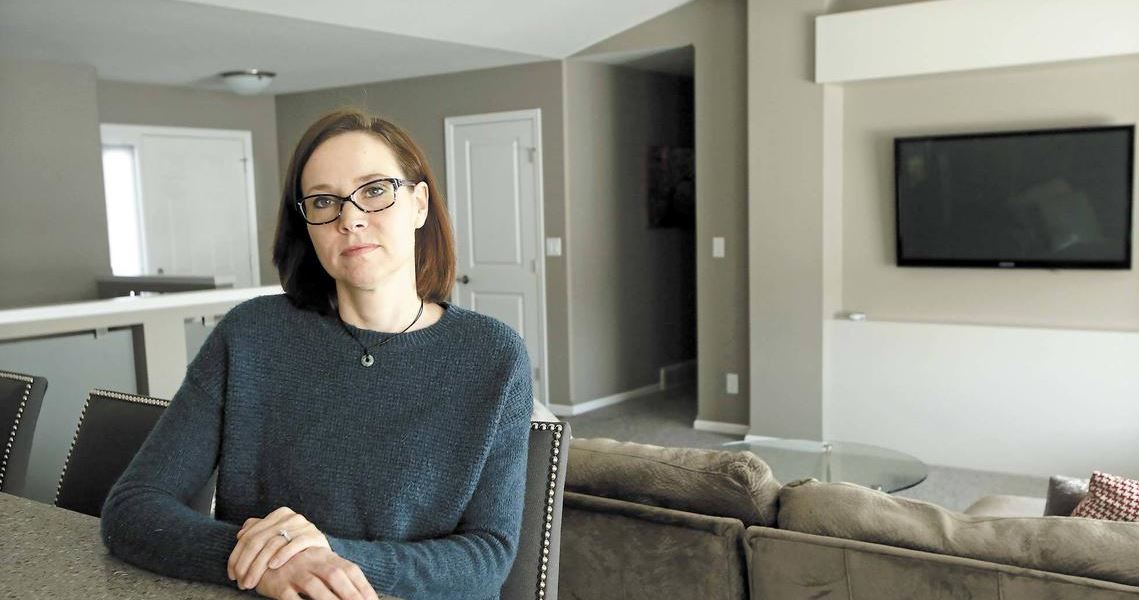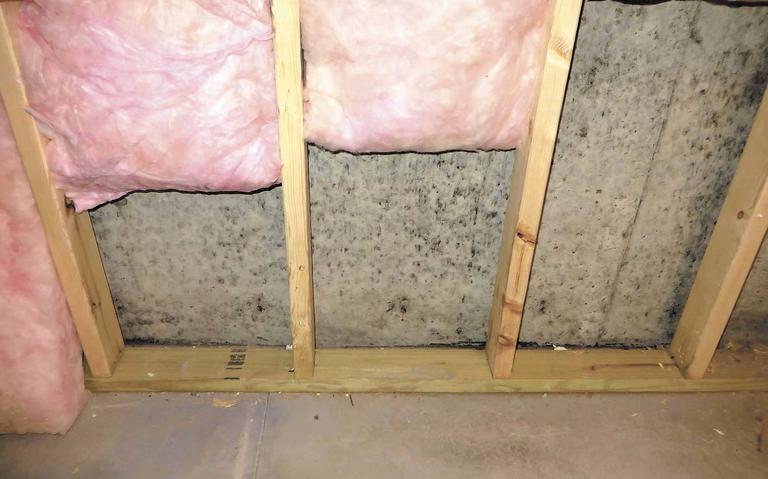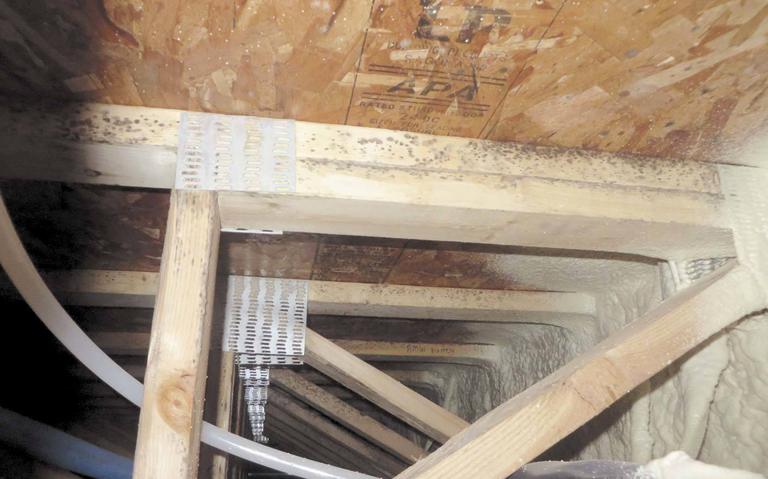Article Written By Ryan Johnson –
Originally Posted On: INFORUM

FARGO – Michelle Torpen knew high humidity in a home could cause a big mold problem, but she was stunned to find out her 3-year-old house had mold – and required an $18,000 fix.
“It seems like when you hear stories about that, it’s in older homes, and certainly not brand-new construction,” she said.
While it’s not an issue in every new house, local inspectors said they’re seeing more instances that could be related to modern building practices and the harsh winter weather here.
Lars Knobloch, owner of Nordic Home Inspection, said one problem is in basement walls. If the studs, insulation and vapor barriers are put up before the concrete foundation is fully dry, he said it can trap moisture and create an environment where mold can flourish.
An even bigger problem, according to Knobloch, can happen in houses built over the winter – especially if the foundation is poured in the fall, then “capped” with flooring joists and a layer of oriented strand boards, or particle board, until the rest is built in the spring.
“The best thing is to not build a house over the winter,” Knobloch said. “But it can be done if the right precautions are made.”
Clay Dietrich, president of Dietrich Homes and president of the Homebuilders Association of Fargo-Moorhead, said mold spores are all around us.
That’s why controlling moisture is the key to prevent mold in homes, he said. Without the right conditions, the spores won’t grow.
“It’s really a moisture issue more than anything,” he said.
Contractors and builders look out for the problem, Dietrich said, because until it’s fully finished, a house under construction is an outdoor environment.
While he said the problem doesn’t seem to be caused by concrete foundations that haven’t dried fully – there isn’t enough moisture by itself to create mold – trying to heat a capped foundation over the winter can be problematic.
“It’s really the builders also being aware of keeping an eye on that and keeping their caps dry enough while they’re waiting to get to them to build,” Dietrich said. “So it’s not something that can’t be dealt with; it’s just something that has to be dealt with to not create problems.”
 Bill Piper, owner of Servpro of Fargo, which handles mold mitigation and remediation, said proper heating and ventilation practices can prevent the problem. Antimicrobial sealers or coatings can help, too.
Bill Piper, owner of Servpro of Fargo, which handles mold mitigation and remediation, said proper heating and ventilation practices can prevent the problem. Antimicrobial sealers or coatings can help, too.
When mold does pop up in new homes, he said it usually can be dealt with without tearing out wood or materials. But it has to be addressed, he said, because left untreated, mold spores will circulate and cause an air quality issue.
The mold in Torpen’s basement was found last year, three years after the house was built, as she was selling the house.
She said the buyer’s inspector saw mold stains on the utility room ceiling – the only basement room with an exposed ceiling.
 Further inspection revealed mold ran throughout the entire ceiling, as well as the basement ceiling of her neighbor’s connected twinhome. While the mold was no longer active because of Torpen’s careful control of humidity levels, the house was unsellable without $18,000 of repairs and remediation.
Further inspection revealed mold ran throughout the entire ceiling, as well as the basement ceiling of her neighbor’s connected twinhome. While the mold was no longer active because of Torpen’s careful control of humidity levels, the house was unsellable without $18,000 of repairs and remediation.
Torpen has since moved into a new home in Fargo, and said the expensive fix of her last house made her nervous to buy new again.
“The thing they do now is they don’t leave any exposed ceiling anymore, so even in our mechanical room, the ceiling’s completed so you can’t see the floor joists,” she said.
Capped concerns
Dean Foell, owner of Tri State Inspection in Fargo, said builders have capped foundations for years. The advantage is the house can be built as soon as winter breaks without delays from wet soil in the spring.
It’s become more common with the community’s “building boom” and high demand for housing.
While it’s a good practice if done properly, Foell said there can be problems if the layer of particle board on top of the capped foundation is reused once the house is built. Because the capped basement is heated over the winter, it’s hotter than the surrounding air, and frost can build up on the boards, acting as a “food” for mold.
Inspectors won’t know if a home had a capped foundation, he said, so it’s important to look closely at the foundation and subfloors on homes.
Still, Foell said it’s the exception and not the norm for new houses built in this manner to have mold issues because builders do what they can to prevent it.
“If they’re following standard practice, then there shouldn’t be a problem,” he said. “If they’re not, that’s when the problem happens. That’s why it’s a lower percentage because for the most part they followed standard practice because the repercussions if it’s not done right are very expensive.”
Minimizing Risks
Knobloch, too, said major mold problems in new hom
es are fairly rare, though he’s seen it more frequently in recent years.
“There’s definitely a lot more homes that don’t have these problems than the homes that do have these problems,” he said. “It’s a small percentage, but there’s so many homes being built.”
He recommends buyers keep up with the builder and be around during the construction process to try to prevent these problems.
But more thorough inspections of homes are optional, and it’s up to the buyer if it’s worth spending roughly $300 to hire a licensed inspector.
Knobloch said it might be better to wait until after moving in to get an inspection. He suggested scheduling one before the home’s warranty expires, when the house has had time to settle and possible issues can become more apparent.
Foell, however, said getting an inspection at the time of purchase is a good idea, too.
“I’ve come across stuff that would lead to a moisture problem,” he said. “If not taken care of, they would’ve had a water problem or a mold problem. It’s a pretty major purchase, and that’s why I always tell them to get your house inspected.”
Foell also tells clients about another potential humidity issue. Modern homes are built much “tighter” than in the past, he said, with better insulation, windows and materials that improve the overall energy efficiency.
While that’s generally a good thing, he said it means new homes no longer will “breathe.”
That’s why homeowners are instructed to rely on air exchangers if their houses have them or to reduce the risk in other ways. Opening blinds and drapes and removing window screens can prevent moisture buildup, he said, and keeping a furnace’s fan running can help recirculate air.
Ultimately, Foell said it’s up to everyone – builders and buyers alike – to learn about the potential for mold and do everything they can to prevent it.
“If the contractors and builder do their job right, and the homeowners are educated on what they need to do when they move into the house, then all the squares are covered,” he said. “Is it going to stop all of it? No. But if you’re doing what you’re trained to do and the contractors are doing what they do, it’s going to minimize the potential problem.”
Summary: Don’t Let Mold Become a Squatter in Your Home
Do you ever find a few moldy spots on the ends of your bread loaf? It’s terrifying isn’t it? Well, imagine finding mold hiding in your home for several years. This is a common problem in plenty of homes because home owners either neglect the issue, or they don’t get a thorough home inspection.
What is Mold?
Mold is a fungus that grows due to high condensation and moisture in places where you may not expect it. Of course, we know it can grow on food that has been left in the refrigerator for too long. But our homes can be invaded by mold without proper maintenance or inspection as well. You never want to ignore the problem because it can cause major problems to your home and your health.
What Causes it to Grow in the House?
The epitome of the cause is too much moisture. With the weather and season changes in North Dakota, we find more evidence of mold because of the dampness in the summer from humidity, and the condensation in the winter. Especially now, with drastic changes in the weather, it is more common to grow and fester.
Don’t Neglect Your Mold Problem
Most home owners don’t realize that even with a newer home, mold can be a big problem if the home inspection wasn’t done the correct way, or the builder made a mistake at the beginning. Lars Knobloch from Nordic Home Inspection deals with a plethora of mold cases on the daily. Lars states, “Mold really grows well in dark areas.” He has found mold in dark places of the basement, and even the attic since most owners never even step foot in their attic.
It can cause health issues because it can contaminate the air. Younger children and the elderly may have worse reactions to the mold even when they can’t see it growing. The issues could be breathing problems, flu symptoms, and other irritations to your health.
What You Should Do
Lars is a certified home inspector with nearly 10 years of experience with home inspection dealing with mold. He conducts a detailed investigation into the home, and he looks for small issues, as well as bigger problems that if ignored, can put a dent in your bank account. He catches the mold before it can become a squatter in your house.
If you believe there is a mold problem in your home, whether you have health problems or a bad smell, contact Lars Knobloch with Nordic Home Inspection at 701-566-1446.
